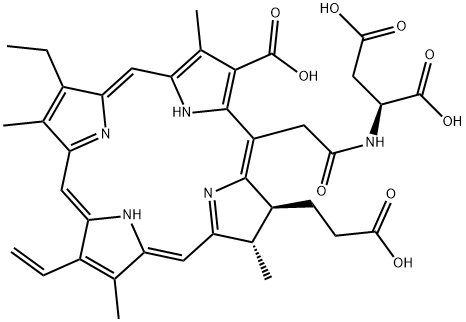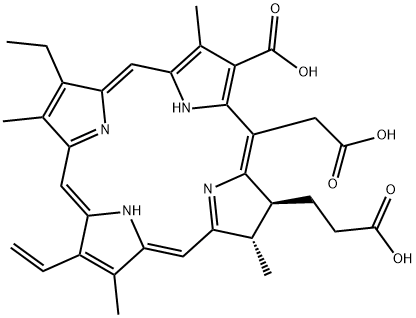monoaspartyl chlorin e6
- CAS NO.:110230-98-3
- Empirical Formula: C38H41N5O9
- Molecular Weight: 711.76
- MDL number: MFCD26960899
- SAFETY DATA SHEET (SDS)
- Update Date: 2024-10-23 13:36:13

What is monoaspartyl chlorin e6?
Description
In collaboration with Light Sciences Corp. and Meiji Seika Kaisha, Nippon Petrochemicals has developed and launched the injectable photosensitizer talaporfin sodium in Japan for the photodynamic therapy (PDT) of cancer. The initial approval is for the treatment of early stage lung cancer, but Light Sciences Corp. and its subsidiaries are also developing talaporfin sodium for other hyperproliferative diseases, such as, liver metastases arising from colorectal cancer, wet age-related macular degeneration, and atherosclerosis. Talaporfin sodium is typically supplied as a lyophilized green powder, and it is synthesized via a carbodiimide-mediated coupling of chlorin e6 (obtained from precursors that were extracted from natural sources) with L-aspartic acid. Since chlorin e6 contains three carboxylic acid groups, the coupling reaction produces a mixture of aspartic acid conjugates. The desired site of conjugation is the acetic acid side chain of C-20, and the other regioisomers are removed by chromatographic purification. Compared to other photosensitizers, talaporfin sodium is associated with minimal cutaneous photosensitivity, is activated at long wavelengths permitting deeper tissue penetration, and requires a shorter interval between intravenous administration and photoactivation. It has a serum half-life of nine hours and is excreted unmetabolized, predominantly by the biliary system. In the clinical study of patients with early lung cancer, a complete response was obtained in approximately 86% of the lesions (administration at 40 mg/m2 followed by laser irradiation at 100 J/cm2, 4–6 hours later). In addition to laser activation, a clinical study involving a variety of refractory solid tumors demonstrated that intratumoral delivery of light-emitting diodes was effective; a 33% overall response rate was observed with no cutaneous phototoxicity. Regardless of the mode of activation, the outcome is the same; the activated photosensitizer reacts with endogenous oxygen to generate singlet oxygen that ultimately leads to apoptosis and vascular ischemia of the targeted tissue. The most significant adverse effect associated with talaporfin sodium was generalized cutaneous photosensitivity, and erythema and oedema were common as well. Individual cases of nausea, vomiting, diarrhea, heartburn, headache, and pruritus were also reported.
Originator
Nippon Petrochem. (Japan)
The Uses of monoaspartyl chlorin e6
Talaporfin is a photosensitizer used in photodynamic therapy.
Definition
ChEBI: Talaporfin is a member of chlorins.
brand name
Laserphyrin
Properties of monoaspartyl chlorin e6
| Boiling point: | 1218.1±65.0 °C(Predicted) |
| Density | 1.359 |
| storage temp. | -20°C Freezer |
| solubility | DCM, EA, MeOH |
| form | Solid |
| color | Dark |
Safety information for monoaspartyl chlorin e6
Computed Descriptors for monoaspartyl chlorin e6
New Products
Tert-butyl bis(2-chloroethyl)carbamate (S)-3-Aminobutanenitrile hydrochloride N-Boc-D-alaninol N-BOC-D/L-ALANINOL N-octanoyl benzotriazole 4-Hydrazinobenzoic acid 3,4-Dibenzyloxybenzaldehyde Electrolytic Iron Powder 1,1’-CARBONYLDIIMIDAZOLE R-2-BENZYLOXY PROPIONIC ACID 4-HYDROXY BENZYL ALCOHOL 1,1’-CARBONYLDI (1,2-4 TRIAZOLE) S-2-CHLORO PROPIONIC ACID (2-Hydroxyphenyl)acetonitrile 4-Bromopyrazole 5-BROMO-2CYANO PYRIDINE 5,6-Dimethoxyindanone 5-broMo-2-chloro-N-cyclopentylpyriMidin-4-aMine 3-(2,4-Dimethoxybenzyl)dihydropyrimidine-2,4(1H,3H)-dione 6-Bromo-3-iodo-1-methyl-1H-indazole 4-Ethylbenzylamine N-(5-Amino-2-methylphenyl)acetamide 2-(BOC-Amino)4-picoline 1-(4-Methylphenylsulfonyl)-1H-1,2,3-benzotriazoleRelated products of tetrahydrofuran
You may like
-
 100-71-0 99%View Details
100-71-0 99%View Details
100-71-0 -
 2 2-BIS(2-HYDROXYETHOXY)-1 1-BINAPHTHYL 99%View Details
2 2-BIS(2-HYDROXYETHOXY)-1 1-BINAPHTHYL 99%View Details
55441-95-7 -
 Chloro Uracil 1820-81-1 99%View Details
Chloro Uracil 1820-81-1 99%View Details
1820-81-1 -
 181228-33-1 (S)-Methyl 3-amino-2-((tert-butoxycarbonyl)amino)propanote Hydrochloride (DAP-OMe. HCl) 99%View Details
181228-33-1 (S)-Methyl 3-amino-2-((tert-butoxycarbonyl)amino)propanote Hydrochloride (DAP-OMe. HCl) 99%View Details
181228-33-1 -
 2-ethyl-6-methyl-3-hydroxypyridine succinate 127464-43-1 99%View Details
2-ethyl-6-methyl-3-hydroxypyridine succinate 127464-43-1 99%View Details
127464-43-1 -
 13162-05-5 N-Vinylformamide 99%View Details
13162-05-5 N-Vinylformamide 99%View Details
13162-05-5 -
 1446013-08-6 98%View Details
1446013-08-6 98%View Details
1446013-08-6 -
 Ste-Glu-AEEA-AEEA-OSUView Details
Ste-Glu-AEEA-AEEA-OSUView Details
1169630-40-3
